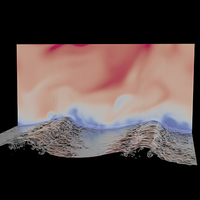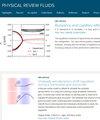破浪风湍流传热数值研究
IF 2.5
3区 物理与天体物理
Q2 PHYSICS, FLUIDS & PLASMAS
引用次数: 0
摘要
通过直接数值模拟研究了破浪风湍流中的热传递。空气-水系统在欧拉网格上模拟,两相之间的界面通过耦合水平集和流体体积法捕捉。为了研究波龄的影响,在空气温度高于水温的情况下,考虑了代表慢波、中波和快波的不同情况。结果表明,平均温度曲线的演变与波龄的增加呈非单调关系。在小波龄时,破浪后水面附近的平均温度会升高。但在中波龄和大波龄时,破浪后温度下降,而在中波龄时下降幅度较大。对温度波动通量的研究表明,波浪相干通量和湍流诱导通量的共同作用导致中波龄处的温度下降幅度较大。对湍流诱导温度通量传输方程中的产生项的进一步分析,阐明了中波龄湍流诱导通量的产生机制。本研究的结果表明,温度对波龄的响应比速度对波龄的响应更复杂,这种现象应在海气相互作用和天气预报模式中加以考虑。本文章由计算机程序翻译,如有差异,请以英文原文为准。

Numerical investigation on the heat transfer in wind turbulence over breaking waves
Heat transfer in wind turbulence over breaking waves is studied through direct numerical simulations. The air-water system is simulated on an Eulerian grid with the interface between the two phases captured by a coupled level set and volume-of-fluid method. To examine the effect of wave age, different cases representing slow, intermediate, and fast waves are considered for the scenario of air temperature being higher than the water temperature. The results show that the evolution of mean temperature profile responds nonmonotonically to the increasing wave age. At a small wave age, the mean temperature near the water surface increases after wave breaking. At intermediate and large wave ages, however, the temperature decreases after wave breaking, while the decrement magnitude is larger at the intermediate wave age. An investigation of the temperature fluctuation flux indicates that a combined effect of wave-coherent flux and turbulence-induced flux leads to a large magnitude of temperature decrement at the intermediate wave age. A further analysis of the production term in the transport equation of the turbulence-induced temperature flux elucidates the mechanism underlying the generation of the turbulence-induced flux at the intermediate wave age. The findings of the present study suggest that temperature responds in a more complex manner to wave age than velocity does and this phenomenon should be considered in models for air-sea interaction and weather forecasting.
求助全文
通过发布文献求助,成功后即可免费获取论文全文。
去求助
来源期刊

Physical Review Fluids
Chemical Engineering-Fluid Flow and Transfer Processes
CiteScore
5.10
自引率
11.10%
发文量
488
期刊介绍:
Physical Review Fluids is APS’s newest online-only journal dedicated to publishing innovative research that will significantly advance the fundamental understanding of fluid dynamics. Physical Review Fluids expands the scope of the APS journals to include additional areas of fluid dynamics research, complements the existing Physical Review collection, and maintains the same quality and reputation that authors and subscribers expect from APS. The journal is published with the endorsement of the APS Division of Fluid Dynamics.
 求助内容:
求助内容: 应助结果提醒方式:
应助结果提醒方式:


